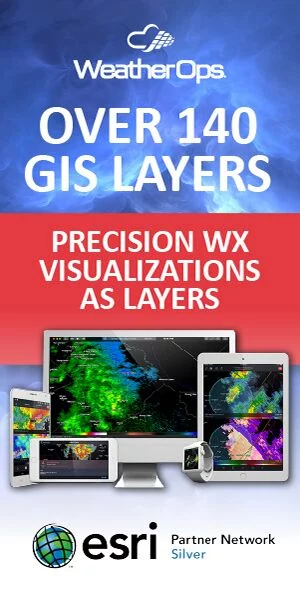In its original implementation, NEXRAD could only detect horizontal measurements of objects in the atmosphere. The dual-polarization upgrades implemented several years ago enable NEXRAD radars to receive both horizontal and vertical data. These data are beneficial in determining precipitation type, filtering non-meteorological clutter, and detecting tornado debris.
Differential Reflectivity
The Differential Reflectivity (ZDR) product shows the difference in returned energy between the horizontal and vertical pulses of the radar. Differential Reflectivity is defined as the difference between the horizontal and vertical reflectivity factors in dBZ units. Its values can range from -7.9 to +7.9 in units of decibels (dB).
Positive values indicate that the targets are larger horizontally than they are vertical, while negative values indicate that the targets are larger vertically than they are horizontal. Values near zero suggest that the target is spherical, with the horizontal and vertical size being nearly the same. Differential Reflectivity is available in two resolutions: 8-bit at 1-degree x 0.25 km resolution and 4-bit at 1-degree x 1.0 km resolution.
Differential Reflectivity values are biased toward larger particles. Stated differently, the larger the particle, the more it contributes to the resulting reflectivity factor. Hence while raindrops usually are wider than they are tall which would tend to yield a positive ZDR value, a scattering of large hailstones in the same volume of air being observed will yield a ZDR value closer to 0, because the spherical shape of the larger objects contributes more to the final reflectivity value. If the base reflectivity product is indicating high dBZ values whereas differential reflectivity is returning values near zero, then the volume in question is likely filled with a mixture of hail and rain.
Correlation Coefficient
The Correlation Coefficient (CC) product is defined as the measure of how similarly the horizontally and vertically polarized pulses are behaving within a pulse volume. Its values range from 0 to 1 and are unitless, with higher values indicating similar behavior and lower values conveying dissimilar behavior. The CC will be high as long as the magnitude or angle of the radar’s horizontal and vertical pulses undergo a similar change from pulse to pulse; otherwise, it will be low. It is available in two resolutions: 8-bit at 1-degree x 0.25 km resolution and 4-bit at 1-degree x 1.0 km resolution.
Correlation Coefficient serves well at discerning echoes of meteorological significance. Non-meteorological echoes (such as birds, insects, and ground clutter) produce a complex scattering pattern which causes the horizontal and vertical pulses of the radar to vary widely from pulse to pulse, yielding CC values typically below 0.8. Hail and melting snow are non-uniform in shape and thus cause a scattering effect as well, but these meteorological echoes have more moderate CC values ranging from 0.8 to 0.97. Uniform meteorological echoes such as found in rain and hail yield well-behaved scatter patterns, and their CC from pulse to pulse generally exceeds 0.97.
The accuracy of the Correlation Coefficient product degrades with distance from the radar. The CC will also decrease when multiple types of hydrometeors are present within a pulse volume. Thus a volume with rain and hail will yield a lower CC than the same volume with solely rain.
Specific Differential Phase
Differential phase shift in general (technically classified as propagation differential phase shift) is the difference between the horizontal and vertical pulses of the radar as they propagate through a medium such as rain or hail and are subsequently attenuated (slow down). Due to differing shapes and concentration, most targets do not cause similar phase shifting in the horizontal and vertical pulses. When the horizontal phase shift is greater than the vertical, the differential phase shift is positive; otherwise, it is negative. Differently stated, horizontally oriented targets will produce a positive differential phase shift, whereas vertically-oriented targets product a negative differential phase shift.
While this correspondence between positive values (horizontal) and negative values (vertical) is analogous to Differential Reflectivity (ZDR), there is a crucial distinction: differential phase is dependent on particle concentration. That is, the more horizontally oriented targets are present within a pulse volume, the greater the positive differential phase shift. Thus a high frequency of small raindrops could yield a higher differential phase value than a lower concentration of larger raindrops. Differential phase shifting is mostly unaffected by the presence of hail, and shifts in snow and ice crystals are typically near zero degrees. Non-meteorological echoes (birds, insects, and so forth) produce highly variable differential phase shifts.
Specific Differential Phase (KDP) is defined as the range derivative of the differential phase shift along a radial. Its possible values range from -2 to 7 in units of degrees per kilometer. It is available in two resolutions: 8-bit at 1-degree x 0.25 km resolution and 4-bit at 1-degree x 1.0 km resolution. It is best used to detect heavy rain. Areas of heavy rain will typically have high KDP due to the size or concentration of the drops. Hail and snow/ice crystals have no preferred orientation and will yield KDP values near zero degrees. Non-meteorological echoes will result in noisy KDP values. KDP is not calculated for areas in which the Correlation Coefficient (CC) is less than 0.9, which will result in gaps in the rendered data.
Hydrometeor Classification
Hydrometeor Classification (HC) is an algorithm to identify the predominant hydrometeor in the radar beam. The pre-defined categories recognized under this classification are as follows:
- BI- Biological (birds, insects)
- GC – Ground clutter (buildings, trees)
- IC – Ice crystals
- DS – Dry snow
- WS – Wet snow
- RA – Light/moderate rain
- HR – Heavy rain
- BD – Big drops
- GR – Graupel (soft ice, snow pellets)
- HA – Hail-rain
- UK – Unknown
- RF – Range folded
The Hydrometeor Classification Algorithm uses several radar products to determine the precipitation type of what is being observed. One important issue to keep in mind is that this algorithm is determining the precipitation type at the beam height, not at the surface. What this means is precipitation at the beam height may be one type (for example, snow), but once it reaches the surface, it could have melted and therefore would be a different type (rain).
Additionally, the Melting Layer Detection Algorithm is used in assigning a precipitation type. One major drawback of this algorithm is it assumes the precipitation does not refreeze. As a result, frozen precipitation such as sleet that is observed at the surface may be identified as rain.
Hybrid Hydrometeor Classification
The Hybrid Hydrometeor Classification Algorithm is an alternative product produced by the Hydrometeor Classification Algorithm. The hybrid algorithm utilizes the lowest available hydrometeor classification output at each radar range bin (accounting for beam-blockage) to assign a precipitation type to that range bin. The information from this scan is then fed into equations that determine both one hour and storm total precipitation. As the precipitation type changes so does the relationship between reflectivity and precipitation amounts. Based on the information received from the scan, the proper algorithm relating reflectivity and precipitation amount is selected. This algorithm is applied, and a precipitation type is assigned.
While the hybrid algorithm is sometimes a more accurate representation of precipitation type, it’s important to note that both algorithms are considered to be works in progress and are susceptible to errors. To gain more insight into precipitation type, other products (especially the dual polarization products) should be utilized. This information, combined with other meteorological data, can provide a clearer picture of what the radar is observing.
Learn More
You can learn more about dual-polarization radar products through these resources:
- RadarScope: Identifying Between Rain, Sleet and Snow
- RadarScope: Difference Between Hydrometeor Classification and Hybrid Hydrometeor Classification
- Dual Polarization Radar: What is Dual-Polarization Radar and What Can It Do For Me?






